How to Fix a Muscle Imbalance in the Legs

Running is a wonderful full-body strengthening exercise. However, oftentimes some muscles get left out of the party while others pick up their slack. This is called a muscle imbalance and can lead to problems such as running injuries down the road.
In fact, many injuries are related to a muscle imbalance in the legs.
The good news is, it’s easy to determine if you have a muscle imbalance by doing a muscular imbalance test. And, it’s easy to fix uneven leg muscles at home.
In this article, we’re going to share:
How to do a muscular imbalance test for the calves, quads, hamstrings, and glutes/hips.
We will also share key exercises to strengthen and fix muscle imbalances.
So, let’s go.
What is a muscle imbalance?
A muscle imbalance is when one muscle group is stronger than the other in the other leg.
Most people have a dominant side of the body. So, our bodies may recruit more power from this stronger side when we run.
Over time, the muscle imbalance grows, and eventually, running injuries like muscle strains and tears, knee pain, back knee pain, tendonitis, lower back pain, IT band syndrome, and piriformis syndrome can arise.
How do you fix a muscle imbalance?
You can fix a muscle imbalance by strengthening the weaker muscle group. It’s as simple as that!
These leg muscle imbalance strengthening exercises are:
- typically simple, requiring little to no equipment
- target the muscle group by using a single leg or hip
- involve slow, intentional, eccentric movements or isometric holds, and,
- (in most cases) these exercises are done every other day
Why are muscle imbalances bad for running?
Muscle imbalances are often the culprit behind running injuries, improper running form, and poor running performance.
Running is a repetitive sport, so if one muscle group is overcompensating for a weaker muscle group, it will eventually break down, causing injury.
The overcompensating also means you aren’t using energy and power as efficiently as you could, making running feel harder. Therefore, your performance suffers.
You want to be able to use both sides of your body equally when you run. Having balanced muscles is the way to do this.
Hips and Glutes Imbalance
Here’s how to tell if you have a muscle imbalance in the hips and glutes:
Single-Leg Squat

- Perform this exercise in front of a mirror or record a video on your smartphone.
- Stand with your feet hip-distance apart.
- Lift one leg out in front of you.
- Then sink your butt down like you’re going to sit in a chair.
- Notice if your knee on your squatting leg caves in or stays straight in line with your hips.
- Repeat the exercise on the other leg.
If one leg caves in, that means you have a glute and hip muscle imbalance. If both legs cave in, both sides of your hips and glutes need strengthening.
Here is an exercise you can do to strengthen your hips and glutes.
Hip and Glute Strengthening Exercise: Clamshell with a Band
- Place a band a bit bigger than the size of your waist over your thighs.
- Lay on one side with your knees stacked and bent 45 degrees in front of you. If you have one weak side, lay with your weak side on top.
- Lift the upper leg and hold for one minute. Feel your glute activate.
- Rest for one minute.
- Repeat 3 times.
- Perform on both sides if both sides are weak.
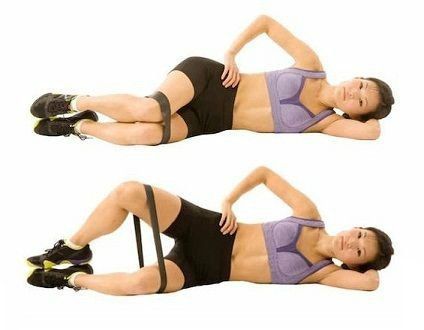
Quad Muscle Imbalance
Here’s how to tell if you have a muscle imbalance in the hips and glutes:
Single-Leg Raise

- Lay on your back with your legs straight in front of you.
- Bend the knee of the leg you think is strong.
- Lock the knee straight of the leg you think is weak.
- Lift the straight leg in front of you and hold it for 3 seconds.
- Do 10 reps. Rest. Repeat for a total of 3 sets.
- Repeat on the other side.
- If your knee bends or your leg wobbles, your quadricep is weak.
If one leg wobbles or shakes, that means you have a quad imbalance on that side. If both legs struggle to perform this exercise, that means both of your quads need to be strengthened.
Here is an exercise you can do to strengthen your hips and glutes.
Quad Strengthening Exercise: Bulgarian Split Squat on Chair
- Stand two feet in front of a knee-high chair with your feet hip-width apart.
- Place the foot of your strong leg on the chair.
- Lean slightly forward and begin to squat so that your knee does not go past the toes of your standing leg. Stop when your thigh is parallel to the floor.
- Repeat 10 times for 3 sets with a 1-minute rest in between.
- Perform on the other side if it is weak, too.
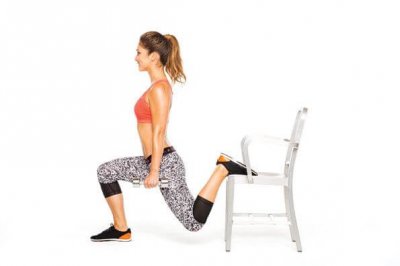
Hamstring Muscle Imbalance
Here’s how to tell if you have a hamstring imbalance.
Single-Leg Bridge
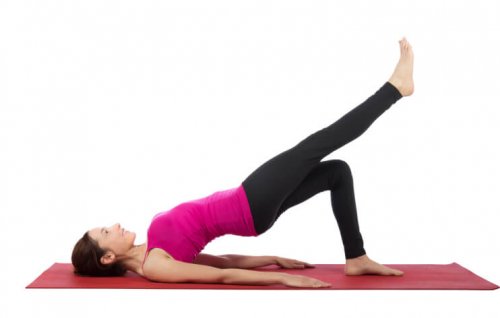
- Lay on your back with your feet hip-distance apart.
- Bend your knees at a 90-degree angle. Hold.
- Push your hips up into a bridge.
- Kick right or left leg straight out so that the other leg is supporting your weight.
- Keep your hips level. No dipping.
- Hold for as long as you can.
- Repeat on the other side.
Note which leg cannot hold the weight as long. This is also likely the leg that tends to have the hip dip. This is your weaker side. If both legs cannot hold the weight, have hamstring cramps, or dip, then both legs need to be strengthened.
Here is an exercise you can do to strengthen your hamstrings:
Single-Leg Slide-Out
- Lay on your back with your feet hip-distance apart on a slippery surface.
- Bend your knees at a 90-degree angle. Hold.
- Push your hips up into a bridge.
- Hold one leg out in front of you so that the other leg is supporting your weight.
- Keep your hips level. No dipping.
- Slide the foot on the floor completely out in front of you slowly.
- Return to starting position.
- Repeat 10 times for three sets. Rest for one minute in between sets.
- Perform exercise on both legs if both hamstrings are weak.

Calf Muscle Imbalance
Here’s how to tell if you have a calf muscle imbalance.
Calf Raise
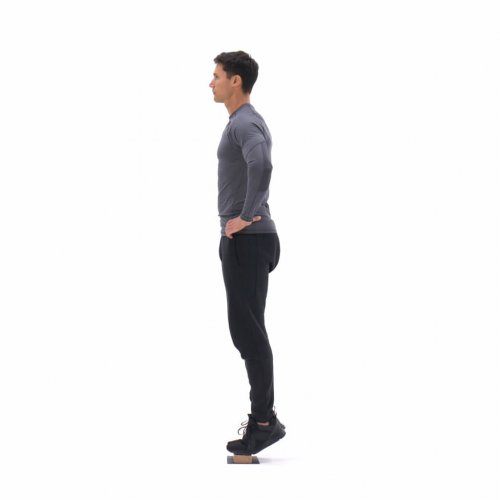
- Stand on a step.
- Lift drop one foot off the step so that the other foot is standing on step with the heel dropped off.
- Stand on your tippy-toe and slowly lower your heel.
- Count as many toe raises on the step you can do.
- Ensure your leg and body are straight, you’re going as high as you can on your toe, and slowly lowering.
- Count how many raises you can do.
- Repeat on the other side.
- If you cannot do 20 raises on both or either side, you have a calf muscle weakness or imbalance.
Here is an exercise you can do to strengthen your calves:
Single-leg Calf Raise
- Repeat the above steps.
- Being intentional about going slow, counting to 5 on the raising and lower.
- Repeat 20 times for 3 sets. Rest one minute in between sets.
- Perform on both legs.
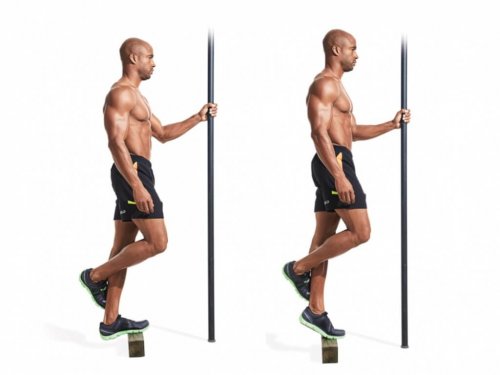
These building strength exercises are beneficial to all runners regardless of a muscle imbalance or asymmetries.
Add them to your strength training routine to be a better, stronger, more balanced runner and reduce the risk of injury!
Latest Articles
 Is Running on a Treadmill Easier Than Running Outside?Runners have their own preferences, whether it is treadmill running, running outside on the road, or exploring trails. So...
Is Running on a Treadmill Easier Than Running Outside?Runners have their own preferences, whether it is treadmill running, running outside on the road, or exploring trails. So... Is It OK to Use Trail Running Shoes on the Road?While trail running shoes can be used on roads, especially in situations where a runner encounters mixed terrains or pref...
Is It OK to Use Trail Running Shoes on the Road?While trail running shoes can be used on roads, especially in situations where a runner encounters mixed terrains or pref... How to Fix Sore Quads After Running?Rest, ice, gentle stretching, and over-the-counter pain relievers can help soothe sore quads after running. Also, ensure ...
How to Fix Sore Quads After Running?Rest, ice, gentle stretching, and over-the-counter pain relievers can help soothe sore quads after running. Also, ensure ... 10 Fruits With The Most Electrolytes to Replace Sports DrinksThese fruits are high in electrolytes such as potassium, magnesium, and calcium, essential for hydration, muscle function...
10 Fruits With The Most Electrolytes to Replace Sports DrinksThese fruits are high in electrolytes such as potassium, magnesium, and calcium, essential for hydration, muscle function...

